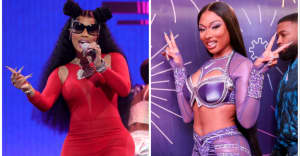The Reality Of Teen-Run Stan Accounts
A new generation of artist fandoms typifies our yearning for 24/7 access.

In late June, just moments after the weekly update of the Billboard Top 200 was released, user @beyonseh tweeted: “drake sold less than the entire BB top 200 but due to streams, he remains number one…” Alongside a screenshot of sales totals for proof, @beyonseh attached an image of Beyoncé in front of an open MacBook. With her fist tucked underneath her chin, she peers at the screen with a slight smirk. As if seeing what we see, Beyoncé is amused. The message of her self-titled 2013 album, and her cultural dominance in its wake, hangs in the air: It’s all about the single. The hype. The shade is real.
Though the haunting melody of Eminem and Dido’s 2000 collaboration has nearly faded from popular culture, stans in 2016 look quite different from the tragic anti-hero who gave us their namesake. This generation has birthed an evolved class of artist fandoms: Little Monsters, Barbz, the Navy, and the Beyhive, among other uber-faithful supporters. In lieu of writing letters, these rabid fanbases track an artist’s every move. There are the conspiracy theorists, too, such as the sub-coalition of Directioners who believe Louis Tomlinson’s son is a decoy, but most stans deal in facts that are very tangible. They can name the designer behind the iconic gold tunic Bey wore at 2011’s Glastonbury Festival in a heartbeat (Alexandre Vauthier) or recite all of 1989’s accolades without misstep. Stans are ruthless about what they know. More than any journalist, perhaps, they are the best historians, critics, and marketers an artist could ever hope for.
Stans are the best historians, critics, and marketers an artist could ever hope for.
“The more you love something or someone, the bigger the urge is to learn more,” Evan Cox, the 18-year-old behind @beyonseh, told me. His is a modest following in the realm of teen internet sensations — 21,500 followers — but Cox’s posts circulate widely. One of his most popular tweets was of footage from Beyoncé’s “Run the World (Girls)” performance at the 2011 Billboard Music Awards, accompanied by the caption, “Me giving a powerpoint presentation on feminism at school.” In response to another user’s incredulity over the success of the tweet, which in its first three months reached over 2 million people, Cox replied: “all my tweets do well sis idk why you're surprised… that’s what happens when you have real followers!”
Stans are made and not born — and sometimes during great strife. Cox began tweeting in earnest in early 2013, what he considered “peak Beyhydration season.” “Beyoncé hadn’t done much of anything in what seemed like centuries,” he said. The drought became an opportunity for Cox to interact with an artist-based community as “a casual fan.” But the more active he became on Twitter, watering the seeds of his blossoming fandom with past interviews and performances from Bey’s career, “the more I started loving Beyoncé and understanding her and her fan base more deeply,” he explained. Later that year his following began to swell, which he attributes to the surprise release of Beyoncé in December. “The [general public] is more interested in artists right after they release content.”
Aaliyah Jewel, @blackheaux, said her entrance to stan culture can be traced to a single event. “I started out as a personal/humor account, and then one day I came across a gif of Zayn Malik and Harry Styles dancing.” She was only 14 years old at the time, but found herself “hooked,” moving from Tumblr to Twitter in 2013 and quickly gaining traction first as a fan account for One Direction and then for Zayn after he left the group.
Cox and Jewel, though, represent stan culture with a twist. They demonstrate an unavoidable truth of our time: teens often make the best e-strategists. Their tweets leave a digital signature quite distinct from the anonymous accounts jockeying to be the most official unofficial fan source. Massive entities like @beyoncereigns (173,000 followers) and @ZaynJMNews (151,000) take on a corporate monotone on par with many singers’ own junkets. Unlike the many dime-a-dozen updaters, Cox and Jewel couple their unconditional stanhood with social media personas all their own. They share selfies along with professional photo spreads of their faves. Tweets about math homework and college applications are strewn between concert footage and Instagram captures. At a glance, their approach is not unlike that of any other user who tweets about the things that matter most to them.
But scroll a bit further and it becomes apparent how their accounts deviate from self-absorption. As teens who are hyper-aware of the worlds they generate and participate in online, Cox and Jewel understand stanning as something beyond a relationship between fan and artist, but a form of community management that comes with ethical responsibilities. How often were Directioners silent on Islamophobia aimed at Zayn? Just as misogynistic appraisals of the artist’s dating history run rampant amongst Swifties, many professed Bey fans will tweet an album cover but never say a word against misogynoir.
Not so with these two. “I believe that it’s important as a big account to talk about these issues,” Cox said, whose pro-LGBT, pro-black, and pro-black women messages are weaved seamlessly into his account’s pro-Beyoncé imperative. His motives, however, are more personal than just Bey. “I think that it’s the fact that I have many people in my life who are heavily affected by the injustice that continuously happens from day to day, and I’m just sick of it.” Cox also runs @PocFashion, a photo catalog of fashion icons of color.
Being curator of your own community is by no means easy. Stan love is messy.
Jewel said she sees parallels between her and Zayn’s commitment to social issues. “He’s reserved, but quite outspoken when he needs to be even if he’ll receive hate for it.” As proof, she cited his infamous “#FreePalestine” tweet, for which he received death threats and no public support from his former bandmates.
Being curator of your own community is by no means easy. Stan love is messy. “A lot of people on here are well into their twenties and thirties and do nothing but live to stir up drama and troll,” Jewel said. “I’ve been teased by grown men and women for being what they consider is too young for Twitter.”
“There have been other Bey stans and other stanbases who have come for me, which I find weird,” Cox added. “[Someone] made a separate account so they could tell one of my mutuals that i liked a tweet against their fave that's a new type of obsession,” he tweeted in July.
As for how often they personally instigate the inter-stan drama, both remained somewhat coy. That’s fitting for a Twitter culture that deals primarily in veiled slights and shady shenanigans. “When I’m bored I will reply just for the kii and the gag, but that’s about it because it usually takes too much energy,” Cox said. And according to Jewel, “Sometimes it’s just easier to block these people and move on.”
Things are, of course, a bit cheekier on Twitter. “Ima always be here girl. You entered my mentions first ,” taunted Jewel in response to a user with girl group Little Mix in their handle. “imagine having to discredit your fave to impress other stans on the Internet,” Cox tweeted amidst an intra-Hive feud. “y’all need to stop hiding behind your bey usernames and avis thinking you won’t get dragged because you have one. i’ll still come for you.”
As an outsider, the displays of fan bravado can seem petty, if not toxic. But what that evaluation of stan culture misses is the wider entertainment egosystem to which stans play a critical part. If debates cause ripples, and ripples keep things interesting, stans are responsible for composing a high-strung concentrate of love and competition that maintains the relevance of an artist even in the absence of their art. And, when the art does come, there’s a home for it to go to.
